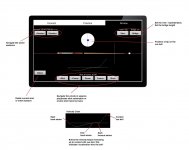I think the severe taper on a snooker cue almost forces you to lower the elbow in a piston manner when cueing. watching Ronnie play and his cue moves up and down quite a lot when feathering. Almost has a scoop type motion. Watching other players that have a more severe piston type feather motion and the cue travels almost perfectly level. A lot has to do with when and how they release the grip. Because Ronnie grips with the middle and back fingers it doesn't release in the traditional way which is why his cue looks to scoop.
I hope others will allow a discussion.
What you said regarding how Ronnie 'connects' to the cue is part of what I was referring to regarding a 'pendulum' stroke. More precisely it's the reverse of what is required to keep the cue on as near a level plane as possible.
To keep the butt from raising as the arm swings back which makes the hand rise, if the elbow does not drop, requires that the 'rod' from the elbow to where the cue is supported in the hand to lengthen as the hand goes back.
One way that that can happen is for it to be shorter in the straight down position. How can one make that 'rod' shorter? One can start with the wrist bent & then go straight as the hand goes back & bend again as the hand comes forward & then go straight for the 'through the ball' portion.
To me, that would be a very unnatural biomechanical maneuver given the direction that the hand is traveling.
I've not seen anyone do that. So, how then does one attempt to keep the cue on a near level plane?
In the thread of more than 18 months ago, it was brought up that the cue changes it's support position along the hand. That being that it would rest on the index finger on the back of the back swing as that would be the lowest point of the hand & it would then transition to resting on the 'pinky' finger in the finish position & be resting somewhere in between during contact.
To me, that is also a very undesirable method for an athlete as the cue is moving within my hand & out of control other than how it is affected by the swing of the arm. One would have to open the fingers other then the index finder for the back swing, rather normal 'feathering', but then on the finish side have to release the index & front fingers so the cue could sit on the 'pinky' finger. I ay release because an athlete would not want the cue to just be sitting there.
That last part seems very unnatural to me unless one is going to 'throw' the cue, which I have & do still do on occasions.
To me, the point of this rather long 'explanation' is that how one connects to the cue will & should be what dictates what stroke is used.
That said, there is very little discussion of the association between the 'grip', connection to the cue, & stroke that should be used for that grip.
IMHO, From what I've read here over my time here, I think very many are attempting to use what to them would be a full pendulum swing but are using a grip, connection to the cue, in a manner that is not really conducive to that type of stroke.
If one is connected to the cue in a manner that is not conducive to the type of stroke that they may 'consciously' be attempting then one is fighting nature, so to speak.
Does one connect to the cue from the bottom & just letting it sit there or does one connect to the cue from the top where it is sort of 'pinched' between the thumb & forefinger or does one connect by sort of wrapping the last 2 or 3 finger around the cue?
One's stroke should match how they are connected to the cue so as to make things more easy &
truly more simple.
I guess that is enough or too much of a rant.
Sorry.
Best 2 All,
Rick
PS I guess another point is that to predispose what type stroke one is going to use makes it a 'work' to do all that will be required to use that contrived & predisposed stroke. Some one said in another thread that what Bagger Vance said in the movie about one finding their own individual swing that is just yours struck a chord with him & made him realize that he was trying to fit into what was basically not him.
